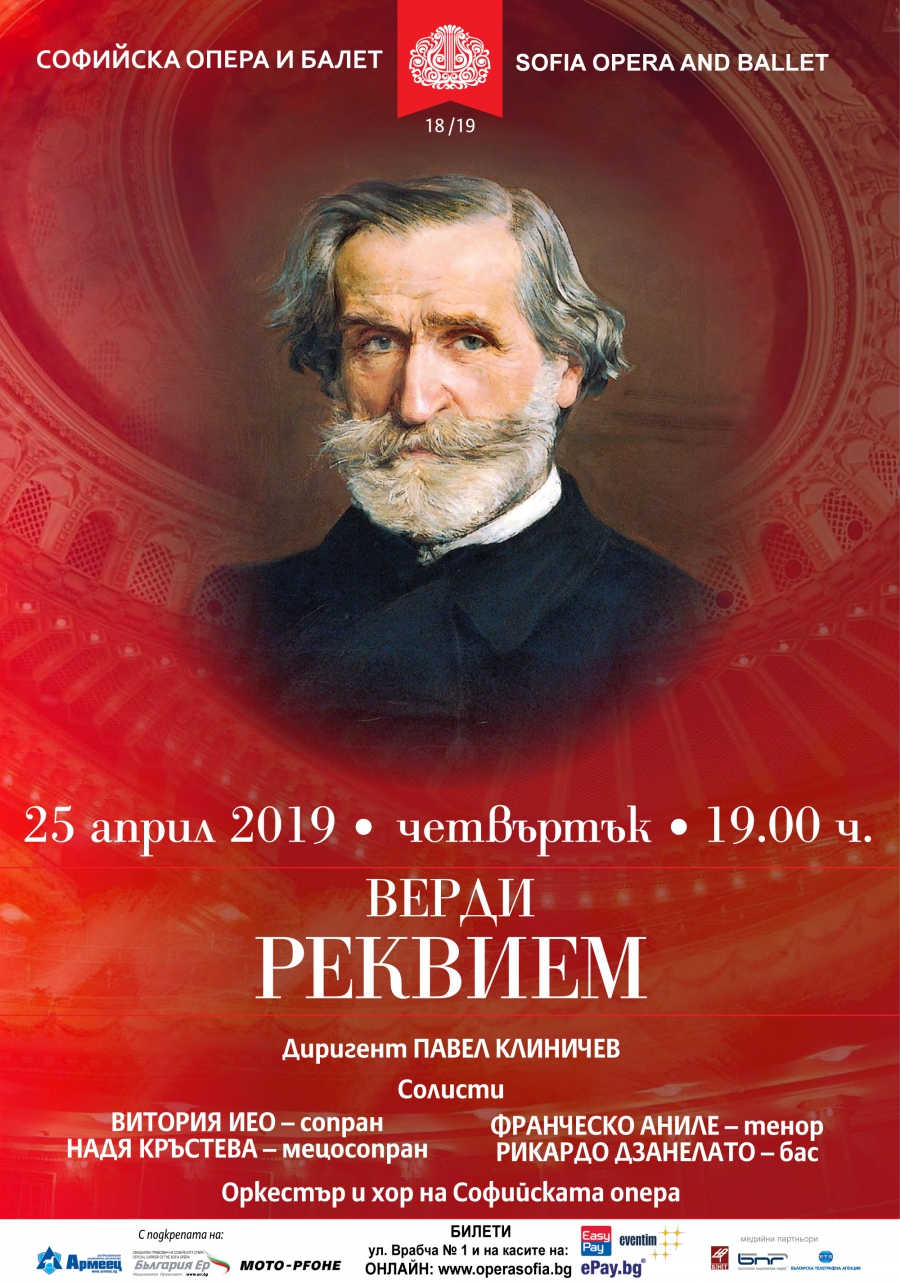| Soloists | |
 VITTORIA YEO, soprano VITTORIA YEO, soprano |
 NADIA KRASTEVA, mezzo soprano NADIA KRASTEVA, mezzo soprano |
 FRANCESCO ANILE, tenor FRANCESCO ANILE, tenor |
 RICCARDO ZANELLATO, bass RICCARDO ZANELLATO, bass |
Choir and orchestra |
|
 Conductor PAVEL KLINICHEV |
Music, which enters intothe heart and shakes the soul
The Sofia Opera presents on 13 April, in the eve of the greatest Orthodox holiday Easter, “Requiem” by Verdi.
The great English writer Bernard Shaw said the following about Verdi’s great work: “This is a music, which enters into the heart and shakes the soul. It may well happen that it lives longer than his operas.”
History of the creation
The intention for the “Requiem” refers to the end of 1868; Rossini’s death inspired Verdi to honour the memory of “the most respected Italian composer”. The idea was the best composers of that time to unite and write a mourning mass on the occasion of the anniversary of Rossini’s death. By lot upon Verdi fell the concluding part, in principle the most attractive for the composers – Libera me. This “Requiem” was written in November 1869, but anyway it was not performed.
Later Verdi decided to write his own “Requiem” in honour to Rossini. The work, however, ran slowly. As a push for its faster completion (at this time Verdi had already composed several parts) served the death of the eminent writer Alessandro Manzoni (22 May 1873), before whom Verdi bowed down still since his youth years, considering him for “a model of virtue and patriotism”.
Verdi finished his “Requiem” on 10 April 1874. Its first performance took place in the year of Manzoni’s death – on 22 May the same year, in the Milan’s cathedral “San Marco”. Behind the conductor’s stand stood the author himself. After several days, the “Requiem” with enormous success was performed at La scala di Milano, also so successfully in1875 passed under the baton of the author the premieres in Paris, London and Vienna, and after that in Munich, in Petersburg…
The composer himself admitted that initially he took for a model the Requiem in C-minor by Luigi Cherubini, a composition for chorus, without soloists, in which to the orchestra as a whole was assigned quite a modest role – but in the process of working Verdi deviated quite a lot from this model: in his “Requiem”, in addition to the big four-part chorus and the full symphonic orchestra, are present also four soloists: soprano, mezzo- soprano, tenor and bass. By style, with its numerous ariosos and ensembles – duets, tercets and quartets – with the true Italian opera cantilena, Verdi’s “Requiem” remind more of his late operas, most of all of “Aida”, than of Cherubini’s work and of other of his predecessors. The role of the orchestra in this requiem goes far outside the frames of the usual accompaniment.
Maybe because of the fact that Manzoni’s death was for Verdi an enormous personal loss, he created a deeply dramatic work, with the inherent for the romanticism sharpness of the experiences, distinctly differing even from his own, written later “Four sacred pieces”, written in a strict, absolutely “church” style. In the “Requiem”, this style reminds only of Agnus Dei.
His “Requiem” Verdi wrote upon a canonical Latin text and that is why in the Sequence before its last part – Lacrimosa, by Verdi is repeated the first part – Dies irae, the fearful picture of the Doomsday, Yom Kippur, and once again Dies irae sounds in the concluding part – Libera me. This way the theme of the Doomsday is woven in the whole “Requiem”, which is not a condition of the canon. As some musicologists suppose, for Verdi this was not the Redemption day in itself, and the merciless invasion of death, yielding only in the lyrical, appeased parts of the “Requiem”, in which the composer input his entire melodic talent.
The “operatic sounding” of this requiem still at his first performances evoked disputes, not stopping even to this day: In which way did the inclusion of elements from the opera affect the liturgical style of the work – did it harm it or did it make it more perfect?…
In Europe Verdi’s “Requiem” at once won an auditorium. After the words of eyewitnesses, it was invariably wildly applauded, some parts were performed over again. Besides, outside of Italy the attitude to the “Requiem” in some countries was, and partially remains dual even to this day: It is considered for a work, belonging rather to the opera genre, than liturgical, and it is being performed like an emblematic, exceptional music drama; to such an extent, that the “Requiem”, like an opera, is being divided in “Act I” and “Act II”. After reviews of critics, so far only the best Italian conductors – at the first place Arturo Toscanini (to him belongs also the first recording of the work – on 27 May 1938 in London with the BBC Orchestra) and Carlo Maria Giulini – manage to take out on the surface the religious feeling in Verdi’s work, to make it sound namely like a requiem mass.
One way or another, together with Mozart’s “Requiem”, the “Requiem” by Verdi is one of the most performed works in this genre.
